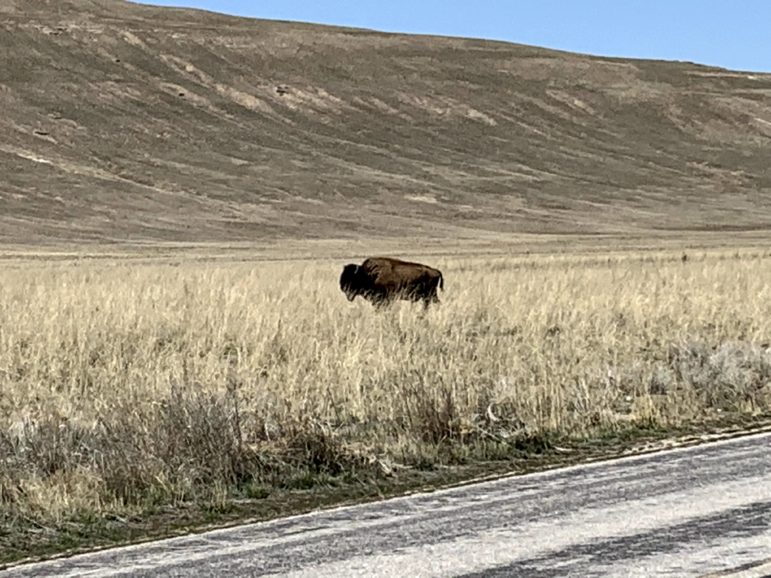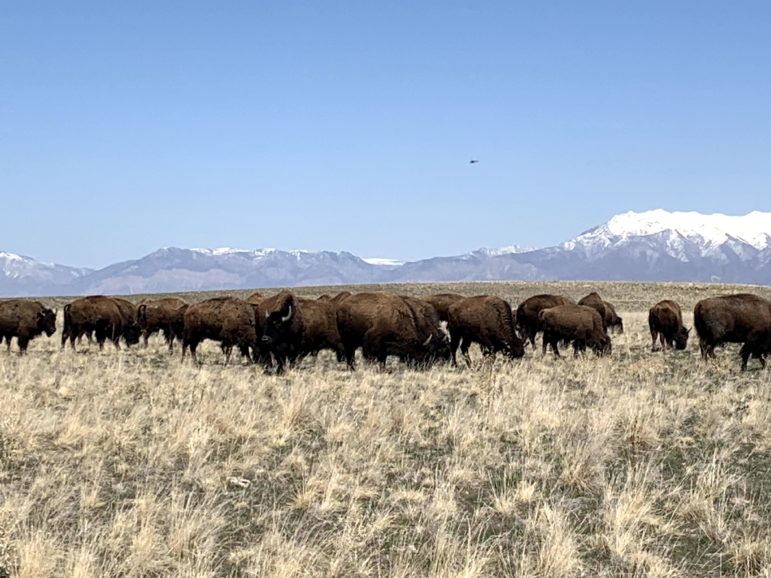
At first we thought they were boulders. Seen from a distance through a veil of ridged earth and shaggy grass, they appeared to be sharply cut stones, dark brown in color, unlike most of the other rocks that littered the prairie, which were pale and moonlike. It was not until one of the boulders stood up and shook out its fur with a snort that we knew for certain what it was. It kicked some dirt back with its hind legs and started to rumble across the basin. We watched it in awe. Not far away, a second one lay still sleeping, its body sometimes hidden entirely by the grass.
“They are enormous,” I said, not much louder than a whisper, to my companion. We were standing on a flat trail a good distance away from the animals, far enough that I wished I had thought to bring binoculars so I could see them better.
“Yes,” she agreed. “How do they not overheat?”
The creature stopped it’s loping and looked at us. Even at this breadth, I imagined that I could see the shine in its liquid brown eyes, peering out from beneath all that fur and horn. It stood there for a time, watching us watching it. My partner bit her lip. She saw a display in the visitor’s center that cautioned tourists not to approach the animals, certainly not to provoke them; despite their bulk, they could run at 35 miles an hour and leap more than eight feet.
“Are you scared?” I asked.
“No,” she said. “I just don’t want to irritate them. That’s all.”

A lone buffalo standing near the road in Antelope Island State Park, Utah [E. Scott]
The herd of bison that live on Utah’s Antelope Island, I read, has lived there since the 1890s, when twelve buffalo were brought to the island by boat. They were brought here as a commercial enterprise; bison had been hunted into near extinction by settlers, to the point that the rancher John Dooley thought he could charge money for the privilege of hunting such a rare animal. Today there are, at times, about 700 of the animals on Antelope Island; at their lowest point, there may have been only about 800 wild bison left in North America, the remnants of herds that once ranged across the continent by the millions.
It turned out that charging people to hunt the buffalo wasn’t profitable enough to sustain the business, but the animals did well on the island despite apparently not having migrated there previously. The herd grew to several hundred in the early 20th century and there were still frequent hunts scheduled. A.H. Leonard, who bought the ranch from Dooley, wanted to raise cattle instead of the difficult bison, and to do that, there needed to be fewer bison on the island. In 1926 he arranged for a massive bison hunt to reduce the size of the herd. Although there was a considerable public outcry, hunters reduced the herd to only 50 animals, an eighth of the size it had been beforehand.
Three years before, in 1923, the buffalo had been used for an early Western film, The Covered Wagon, in which seven of the animals had been shot and killed. “Don’t grow sentimental over the seven,” said the director of the film, James Cruze. “The folks out there would like to get rid of the whole herd and they would, but for the sentimental hubbub that is always raised when they talk of rounding out the buffalo.” Such was the sentiment when Leonard held his hunt; as white settlers had displaced Indigenous tribes, so had the cattle displaced the buffalo. To see this as anything other than inevitable, if not just, was to engage in naive longing for “the America of the past.”
That was a century ago; in the time since, the state of Utah purchased Antelope Island, the northern half in the 60s, and the rest, including the historic ranch, in the early 80s. The herd is now publicly owned. Since then the herd has thrived, not only increasing its numbers but also becoming valued by scientists and conservationists for their genetics – every autumn the buffalo are rounded up for observation and healthcare, and some are sent off to other herds and a few are sold at auction to commercial buffalo ranches. For the most part, though, they wander as they will around their island, with nothing more to disturb them than people like us, who come to stare at them with wonder.

A herd of bison in Antelope Island State Park, Utah [E. Scott]
“Prehistoric people inhabited the island more than 6,000 years ago,” notes the Antelope Island State Park brochure. “More recently, Fielding Garr established the first permanent residence on the island in 1848.” Such are the incredible movements through time and culture found in the popular history of the American West, like the match-cut Stanley Kubrick used in 2001.
The park’s website is only a little better; it states that the Ute people lived in the area until the late 1840s (that is, when white settlers arrived), and beyond that, the only mention of Indigenous people in the history statement is a note that “Daddy Stump” was “believed killed by Indians” in 1856. The timeline for the settlers, by contrast, reads like entries from the Anglo-Saxon Chronicle, with notes on the various sales and operations of the island’s ranch, along with peculiarities like this: “1894: Ten elk brought to the island. These elk were later killed by vandals.” Most of the public-facing history focuses on the island being named by John Fremont and Kit Carson, frontiersmen whom many view as being prime actors in the genocide of Indigenous people during the settlement of the American West.

The causeway that allows cars to travel across the Great Salt Lake to Antelope Island National Park; it was only constructed in 1992 [E. Scott]
I came out to Utah to see my companion, not out of specific interest in Antelope Island. A week ago I was not actually aware that the Great Salt Lake had islands at all, much less one big enough to sustain 700 bison along with pronghorns, mule deer, and porcupines. We went because we found the brochure in our cabin’s guestbook and it seemed like a good way to spend the day. And it was, especially on our way back out, when we saw a great gathering of the buffalo right next to the road, scuffling and playing with each other, occasionally spilling over onto the blacktop. A truck with Texas plates pulled off the road ahead of us, and the woman in the passenger seat got out, presumably to look more closely at the animals, much to the consternation of my companion, worried that the woman would do something to upset the herd.
We were close enough to the buffalo that we could see the individual character of their faces – close enough that they had the shock of reality, the realization that we were here and they were here and the span between us was only forty or fifty feet. These moments do not come around that often – not for me, at any rate – but they are the moments when I am most glad to have been raised a Pagan because that sublime experience of worldliness is one of the main tenets of the religion for me.
My companion is driving us back from the park now. We are in her convertible with the top flipped down, and as the wind whips through my hair along Interstate 80, I find my mind returning, again and again, to the bison we saw on the trail, those boulders in the grass come to life. They seemed ever-present and eternal, an indelible part of the island – yet they are not. They have only been there for a little over a century. Many things have come and gone, changed, been erected, been destroyed, even on this island in the middle of America; the living world does not know eternity.
Ahead of us on the road lie mountains, some of whose peaks are barren today after being capped with snow on Tuesday. Like the buffalo, their presence seems unchanging, ineradicable. It that very permanence that now makes me wonder how human hands have shaped them, which human tongues have named them, and then been forgotten, or erased.
The Wild Hunt is not responsible for links to external content.
To join a conversation on this post:
Visit our The Wild Hunt subreddit! Point your favorite browser to https://www.reddit.com/r/The_Wild_Hunt_News/, then click “JOIN”. Make sure to click the bell, too, to be notified of new articles posted to our subreddit.